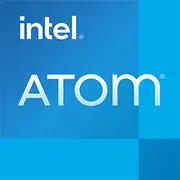Intel Atom Z2460

Intel Atom Z2460 (Penwell): A Budget Processor for Niche Tasks in 2025
April 2025
Intel Atom processors have always been associated with compact devices where energy efficiency takes precedence over performance. The Atom Z2460 (codename Penwell), released over ten years ago, can still be found in ultra-budget laptops and hybrid devices. But is it still relevant in 2025? Let's dive into the details.
Architecture and Manufacturing Process: Minimum Cores, Maximum Savings
Single Core, Single Thread, 32 nm
The Atom Z2460 is built on the Saltwell microarchitecture (part of the Medfield platform), which is an evolution of Bonnell. It is a 32-nm chip with a single core and a single thread (Hyper-Threading is absent). The base clock frequency is 1.3 GHz, but thanks to Intel's Burst Performance technology, it can briefly boost to 1.6 GHz under load. However, under a TDP of 3 W, the "turbo" mode is very conservative, and its duration is limited.
Integrated Graphics
The processor is equipped with a GMA (Graphics Media Accelerator) core, with the exact model varying by source. The PowerVR SGX540 is most commonly mentioned—a solution that supports DirectX 9 and has modest performance. By 2025, this is considered outdated: even simple games like Among Us will only run at minimum settings, and rendering modern web content (WebGL, HTML5) will lag.
Power Consumption and TDP: 3 W as the Key Advantage
A TDP of 3 W is the main advantage of the Z2460. This allows for:
- The elimination of active cooling (fans), making devices silent.
- The creation of ultra-thin cases (e.g., tablets less than 8 mm thick).
- Battery life of up to 10–12 hours with a battery capacity of 30–35 Wh.
However, the low TDP is achieved by radically cutting performance. In multitasking scenarios (e.g., a browser with 5+ tabs + a messenger), the processor quickly gets overloaded.
Performance: Basic Tasks and No Illusions
Office Work
- Text Editors (Word, Google Docs): acceptable speed when working with documents up to 50 pages.
- Spreadsheets (Excel): formulas with simple calculations work without issues, but pivot tables or macros will cause lags.
- Email and Messengers: stable, as long as heavy attachments are not opened.
Multimedia
- Video: 1080p@30fps (H.264) playback is possible, but 4K or HEVC is not supported.
- Audio: no problems, even with other applications running in the background.
Gaming
- Old Games: Half-Life 2, Counter-Strike 1.6—30–40 FPS at low settings.
- Indie Projects: Stardew Valley, Terraria—playable, but with occasional freezes.
- Cloud Gaming (GeForce Now, Xbox Cloud): the only way to run modern titles.
Turbo Mode
The short-term boost to 1.6 GHz is almost unnoticeable in real scenarios. For example, when opening a heavy web page, the processor speeds up for a second but then returns to the base frequency to avoid exceeding TDP.
Use Cases: Who Is the Z2460 Suitable For in 2025?
1. Educational Devices: Budget laptops for students (e.g., models like the Lenovo IdeaPad Slim 1), where price ($200–250) and long battery life are crucial.
2. Office "Typewriters": For employees only working with 1C:Accounting or Google Workspace.
3. Backup Devices: Compact tablets with keyboards for travel (e.g., Chuwi HiBook).
categorically unsuitable for:
- Video/photo editing.
- Virtualization, programming in heavy IDEs (Visual Studio, PyCharm).
- Running Windows 11 (requires at least 2 cores).
Battery Life: 12 Hours Is Not a Myth
With a 35 Wh battery capacity (typical for Z2460 devices), the working time reaches 10–12 hours due to:
- Intel SpeedStep: dynamic frequency reduction during idle.
- Turning off unused components: Wi-Fi module, sensors.
- Passive cooling: no energy consumption for a fan.
However, battery life drops sharply with active use of Wi-Fi and screen brightness above 50%.
Comparison with Competitors: In the Face of Modern Chips
1. AMD Athlon Silver 3050e (2020): 2 cores/2 threads, TDP 6 W. 2–3 times faster in multitasking, but battery life is halved (6–7 hours). Laptop prices start at $300.
2. Apple M1 (2020): even after 5 years, shows 10–15 times higher performance at a similar TDP. Devices with M1 start at $600, which is three times more expensive.
3. Intel N100 (2023): 4 cores, TDP 6 W. Supports 4K, NVMe SSD. Laptops start at $350.
Conclusion: The Z2460 lags behind even budget chips from the 2020s but wins on price and battery life.
Pros and Cons
Strengths:
- Record low power consumption.
- Compact and silent devices.
- Laptop prices starting from $200.
Weaknesses:
- Struggles with multitasking.
- Outdated graphics (no support for Vulkan, DirectX 12).
- Limited compatibility with modern software.
Recommendations for Choosing a Laptop
If you still decide to buy a device with the Z2460, pay attention to:
1. Storage type: SSD is essential (even 64 GB eMMC is enough for Windows 10 LTSC).
2. RAM: at least 4 GB (but better 8 GB for Linux).
3. Screen: An IPS matrix with a resolution of 1366×768 provides the best price-to-quality balance.
4. Ports: USB-C with Power Delivery support simplifies charging.
Examples of models from 2025:
- HP Stream 11 Pro: 11.6" IPS, 4 GB RAM, 128 GB eMMC — $229.
- ASUS Laptop E210: 12.5" HD, 8 GB RAM, 256 GB SSD — $279.
Final Conclusion: Who Is This Processor For?
The Atom Z2460 is a choice for those who:
- Seek the cheapest laptop for browsing websites, working with documents, and communication.
- Value battery life over speed.
- Are willing to tolerate limitations in favor of compactness.
Key Benefits: Price, battery life, silence. In 2025, the Z2460 is not a relevant processor but a relic of the past that still clings to the market thanks to the ultra-budget segment. If your budget allows you to spend $100–150 more, it's better to choose a device with the Intel N100 or AMD Mendocino—these would be more sensible investments.
Basic
CPU Specifications
Memory Specifications
GPU Specifications
Share in social media
Or Link To Us
<a href="https://cputronic.com/cpu/intel-atom-z2460" target="_blank">Intel Atom Z2460</a>